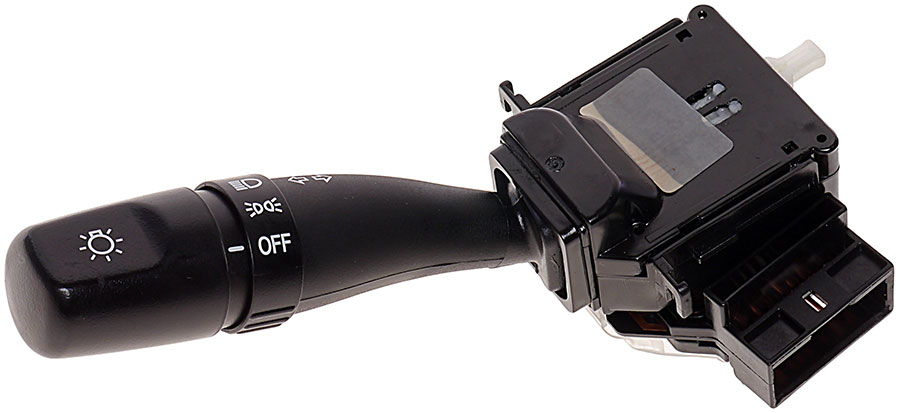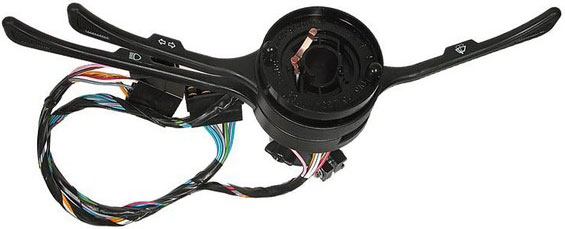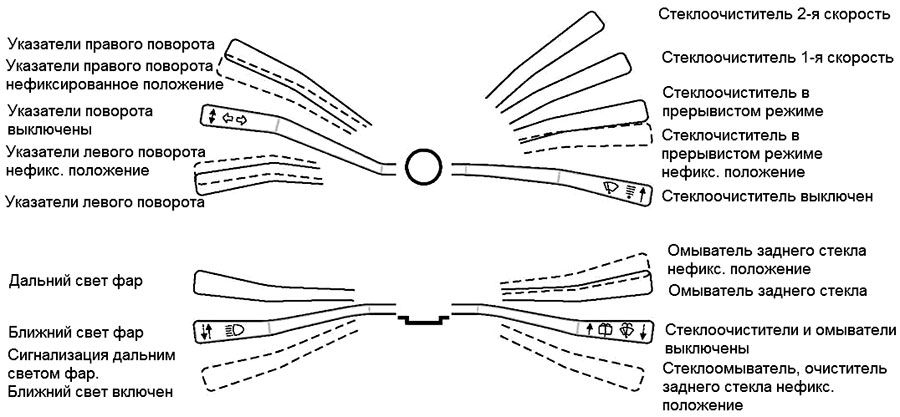
In cars, the controls of auxiliary devices (direction indicators, lighting, windshield wipers and others) are placed in a special unit - the steering wheel switch. Read about what paddle shifters are, how they work and work, as well as their selection and repair in the article.
What is a paddle shifter?
Paddle shifters are controls for various electrical devices and systems of the car, made in the form of levers and mounted on the steering column under the steering wheel.
Paddle shifters are used to control those electrical appliances and systems of the car that are often used while driving - direction indicators, head lights, parking lights and other lighting equipment, windshield wipers and windshield washers, sound signal. The location of the switches of these devices is advantageous from the point of view of ergonomics and safety of driving: the controls are always at hand, when using them, the hands are either not removed from the steering wheel at all, or are removed only for a short time, the driver is less distracted, retains control of the vehicle and the current traffic situation.
Types of paddle shifters
Paddle shifters differ in purpose, number of controls (levers) and number of positions.
According to their purpose, paddle shifters are divided into two types:
• Turn signal switches;
• Combination switches.
Devices of the first type are intended only for controlling direction indicators, today they are rarely used (mainly to replace similar devices in case of their malfunction on early models of UAZ cars and some others). Combined switches can control various devices and systems, they are the most widely used today.
According to the number of controls, paddle shifters can be divided into four main groups:
• Single-lever - there is one lever in the switch, it is located (as a rule) on the left side of the steering column;
• Double-lever - there are two levers in the switch, they are located on one or both sides of the steering column;
• Three-lever - there are three levers in the switch, two are located on the left side, one on the right side of the steering column;
• One- or double-lever with additional controls on the levers.
The switches of the first three types have only controls in the form of levers that can turn on and off the devices by moving in a vertical or horizontal plane (that is, back and forth and / or up and down). Devices of the fourth type can carry additional controls in the form of rotary switches or buttons directly on the levers.

Double Lever Switch

Three Lever Switch
A separate group consists of paddle shifters installed in some domestic trucks and buses (KAMAZ, ZIL, PAZ and others). These devices have one lever for turning on the direction indicators (located on the left) and a fixed console (located on the right), on which there is a rotary switch to control the lighting fixtures.
According to the number of lever positions, switches can be divided into three groups:
• Three-position - the lever moves only in one plane (up and down or back and forth), it provides two working fixed positions and one "zero" (all devices are turned off);
• Five-position single-plane - the lever moves only in one plane (up-down or forward-backward), it provides four working positions, two fixed and two non-fixed (the devices are turned on when the lever is held in these positions by hand) positions, and one "zero";
• Five-position two-plane - the lever can move in two planes (up-down and forward-backward), it has two fixed positions in each plane (a total of four positions) and one "zero";
• Seven-, eight and nine-position two-plane - the lever can move in two planes, while in one plane it has four or five positions (one or two of which can be non-fixed), and in the other - two, three or four, among which there is also a "zero" and one or two non-fixed positions.
On paddle shifters with rotary controls and buttons located on the levers, the number of positions may be different. The only exception is turn signal switches - most modern cars are equipped with five-position switches, or seven-position turn switches and headlight control.
Functionality of paddle shifters
The paddle shifters are assigned the functions of controlling devices of four main groups:
• Direction indicators;
• Head optics;
•Wipers;
• Windshield washers.
Also, these switches can be used to control other devices:
• Fog lights and rear fog light;
• Daytime running lights, parking lights, license plate lights, dashboard lighting;
•Beep;
• Various assistive devices.

Typical scheme for switching on instruments with paddle shifters
Most often, with the help of the left lever (or two separate levers on the left side), turn indicators and headlights are turned on and off (in this case, the dipped beam is already turned on by default in the "zero" position, the high beam is turned on by transferring to other positions or the high beam is signaled). With the help of the right lever, the windshield wipers and windshield washers of the windshield and rear windows are controlled. The beep button can be located on one or both levers at once, it is installed, as a rule, at the end.
The design of the paddle shifters
Structurally, the paddle shift switch combines four nodes:
• Multi-position switch with electrical contacts for connection to the control circuits of the corresponding devices;
• Controls - levers on which buttons, ring or rotary handles can be additionally located (while their switches are located inside the lever body);
• Housing with parts for attaching the switch to the steering column;
• In turn signal switches, the mechanism for automatically turning off the pointer when the steering wheel rotates in the opposite direction.
At the heart of the whole design is a multi-position switch with contact pads, the contacts of which are closed by contacts on the lever when it is transferred to the appropriate position. The lever can move in one plane in the sleeve or in two planes at once in the ball joint. The turn signal switch is in contact with the steering shaft through a special device, tracking the direction of its rotation. In the simplest case, it can be a rubber roller with a ratchet or other mechanism associated with a lever. When the direction indicator is turned on, the roller is brought to the steering shaft, when the shaft rotates towards the turn signal turned on, the roller simply rolls along it, when the shaft rotates back, the roller changes the direction of rotation and returns the lever to the zero position (turns off the direction indicator).
For the greatest convenience, the main controls of the paddle shift are made in the form of levers. This design is due to the location of the switch under the steering wheel and the need to bring the controls to the optimal distance to the driver's hands. Levers can have a variety of shapes and designs, they indicate the functionality with the help of pictograms.
Issues of selection and repair of paddle shifters
By means of paddle shifters, devices and systems critical for safe driving are controlled, so the operation and repair of these components must be approached responsibly. Turn the levers on and off without excessive force and shock - this will extend their service life. At the first sign of a malfunction - the impossibility of turning on certain devices, unstable operation of these devices (spontaneous switching on or off while driving), crunching when turning on the levers, jamming of the levers, etc. - the switches must be repaired or replaced as soon as possible.
The most common problem of these devices is oxidation, deformation and breakage of contacts. These malfunctions can be eliminated by cleaning or straightening the contacts. However, if a malfunction occurs in the switch itself, then it makes sense to replace the entire node. For replacement, you should buy those models and catalog numbers of the paddle shifters that are specified by the vehicle manufacturer. By choosing other types of devices, you risk just spending money, since the new switch will not replace the old one and will not work.
With the right choice and careful operation, the paddle shifter will work reliably for many years, ensuring the comfort and safety of the car.
Post time: Aug-21-2023
